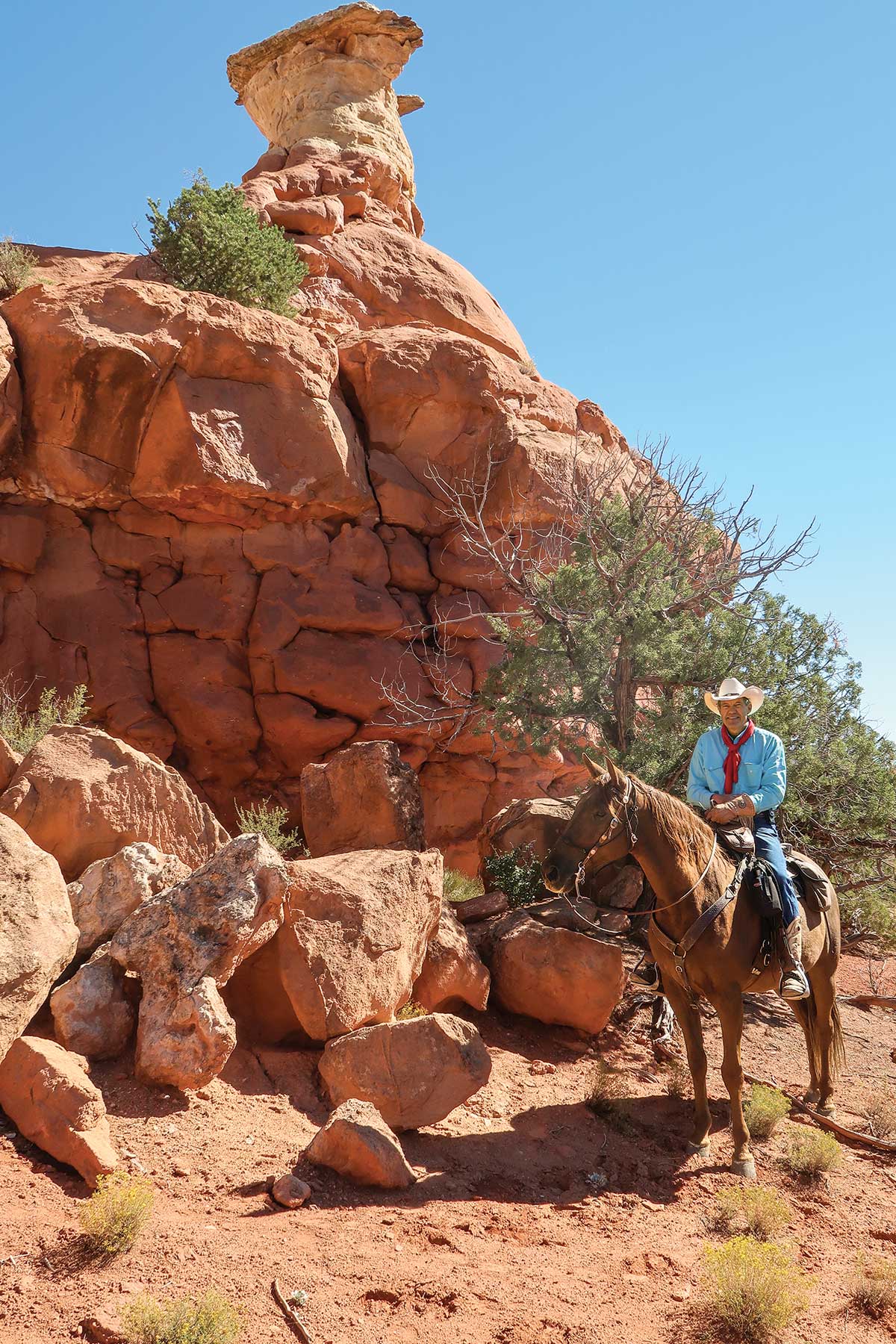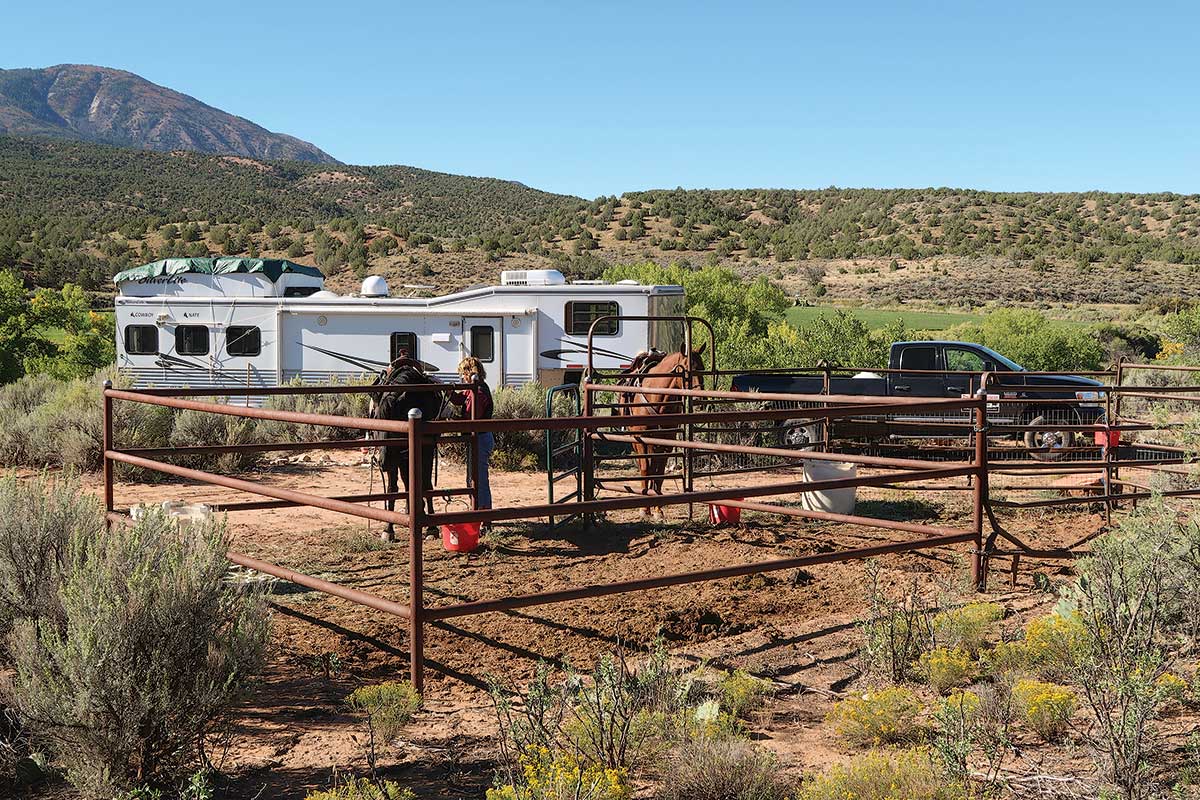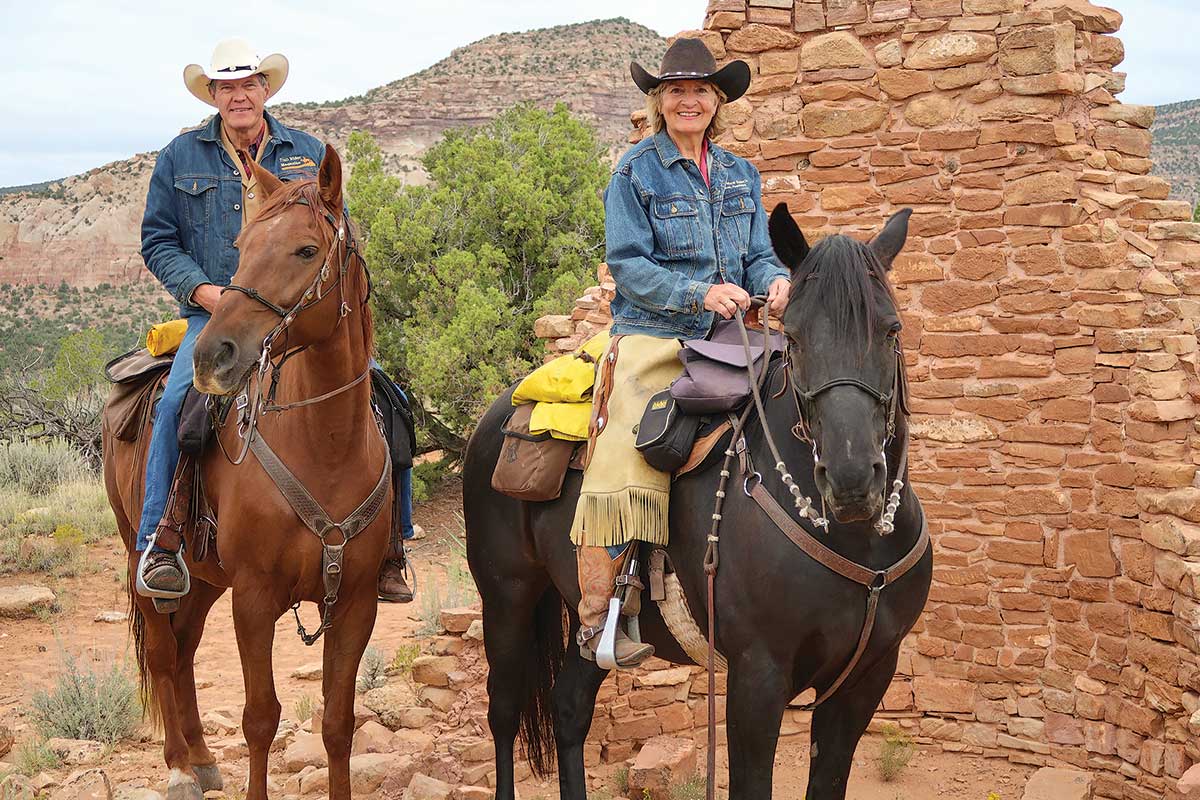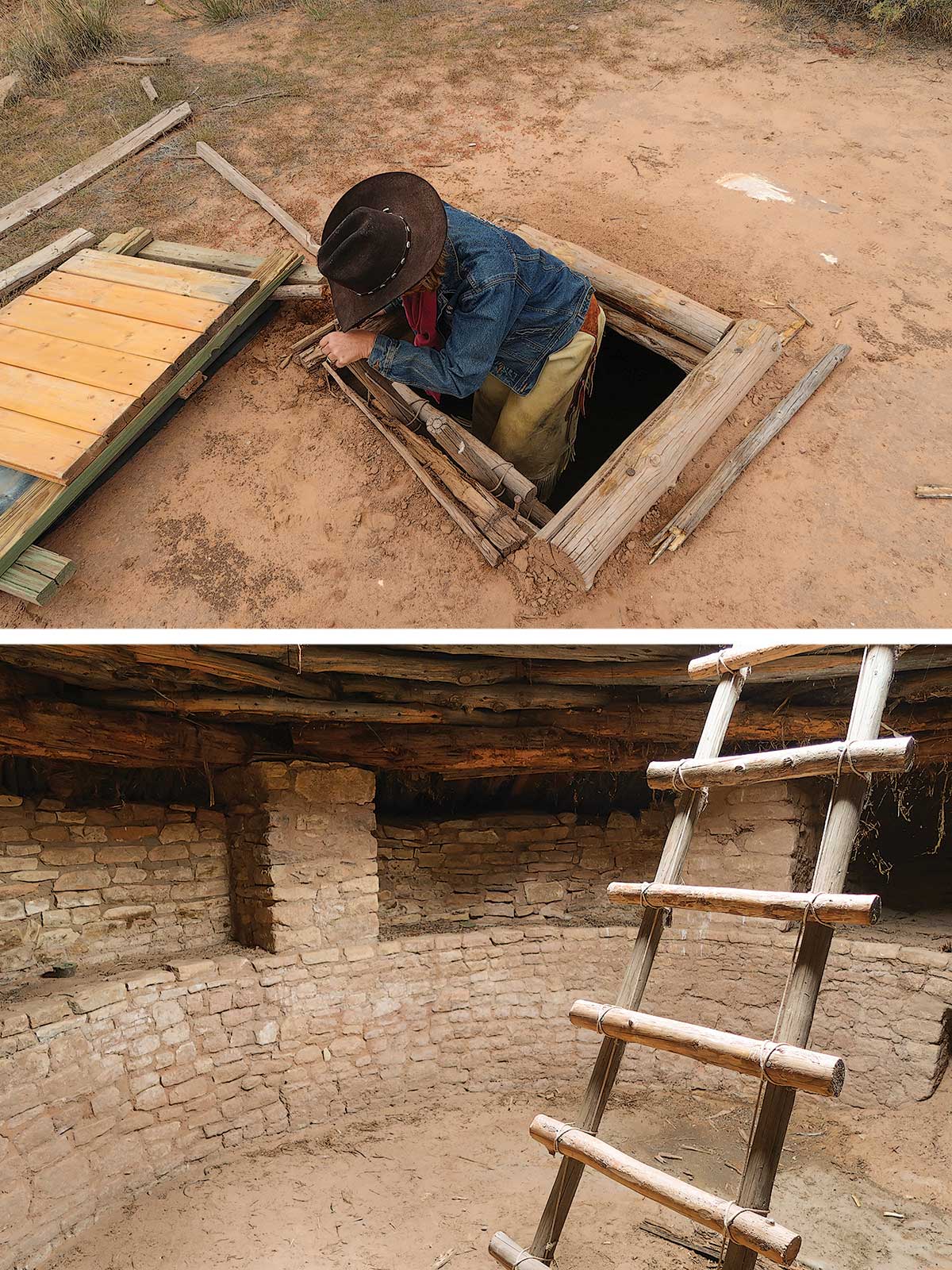
Canyons of the Ancients. The very name conjures visions of ghostly figures gazing from cliff dwellings in high, shady alcoves. Canyons of the Ancients National Monument, located in Colorado’s Four Corners region, is an enchanting place to bring your equine partner and discover both history and beauty. We explored the area aboard our well-traveled Missouri Fox Trotter geldings, Cowboy and Nate.
Canyon Trails Ranch
Canyon Trails Ranch (canyontrailsranch.com) is located about a mile from the Canyons of the Ancients boundary, 15 miles southwest of Cortez. It offers an equine-friendly campground situated on a gentle rise overlooking an emerald field framed in the layered, sun-kissed cliffs of McElmo Canyon. Sagebrush, pinyon pine, and prickly pear cactus adorn the campground. Each campsite has water, electricity, and a corral. We stayed here four nights and had the entire four-unit campground to ourselves.
Ranch owners Kristie and Rodney Carriker are both horse people. Kristie specializes in cutting horses, while Rodney prefers horse packing. Rodney also restores historic carriages and wagons.
Kristie is an amateur archeologist and Native American historian. She’s worked with the Bureau of Land Management on cliff dwellings and generously shares her knowledge and enthusiasm for history with ranch guests.
The day after we arrived, Kristie took us on a six-hour, guided horseback tour of BLM property aboard her horse Tonka. Half this time was spent riding, while the other half was spent exploring and learning about the ancient Puebloan people (also known as the Anasazi) who once inhabited this vast country. Overall, there are an estimated 1,400 ruins in this area.

A Glide Through Time
Riding with Kristie was like having a magician open the windows of time and gliding through them. She views the past in terms of artistic people who had families—people who struggled for a living, yet strongly needed to express themselves through their art.
“They put art into everything they did,” Kristie said, pointing to a chunk of petrified wood an ancient homebuilder had strategically placed in a cliff-dwelling wall. “People need art in their lives—it’s a way to express themselves.”
Kristie led us to six ruins: two towers and four cliff dwellings. We explored two of the cliff dwellings, which are 800 to 1,200 years old. Rocks used in construction were all sizes, yet the builders were able to create even wall surfaces. The towers’ purposes were varied. Some Hopi tribal advisors think the towers were used as lookouts for fires and enemies, to spot game, to sky-watch, and to decide when to plant crops. (The Puebloan people were ancestors of the modern Hopi and Zuni people.)
We then rode past white-and-pink cliffs splashed with greenery and colorful wildflowers.
At the second cliff dwelling, Kristie held us spellbound. A transformation had occurred—she “became” an ancient Puebloan mother working in her cliff-dwelling kitchen.
That hole by the floor? It was where Mom ground corn into meal for the family’s bread. That slice in the rock wall? Mom used it to sharpen her obsidian knife. And those little holes in the wall? There, Mom secured wooden rods she used for drying thinly sliced meat, or maybe vegetables, so she could save them for later use.
Kristie bustled around in the dwelling’s kitchen, chatting about the family who might’ve lived there. Suddenly, she leaned out the doorway, shouting at an imaginary child. She pointed out to us how Mom might’ve done the same thing, leaving the charcoal-smudged handprint.
At the end of the tour, Kristie shared something special with us. On their property, the Carrikers had discovered a kiva—a round, underground room used by ancestral Puebloans for domestic, social, political, ceremonial, and religious purposes. The roof had caved in, and the kiva was filled with soil and rocks. The Carrikers excavated it and put on a new roof, but everything else is original. It’s thought to be one of the best restored kivas in the Southwest.
The kiva had a tranquil, spiritual feeling. We felt honored that Kristie chose to share it with us. She told us that the round depression behind our corrals in the campground was another caved-in kiva.

Sand Canyon Trail
The next day, we rode from our camp to County Rd. G and turned right. Within a mile, we were at the trailhead to Canyons of the Ancients National Monument. Trailhead parking is severely limited, so riding along the road is a good option.
At the trailhead, Castle Rock, a noted landmark, is on the right. Continue on ahead, riding carefully on the slab rock, and follow the Sand Canyon Trail markers. You can ride up this trail about 4 miles before it’s closed to horses due to narrow, steep switchbacks. This makes for a 10-mile-loop ride altogether.
Sand Canyon Trail is extraordinary in beauty and gives the opportunity of discovery. What’s around the bend? Another tower? A hidden dwelling? In places, the trail is rocky but safe. The trail’s edges are scalloped with pinyon pines; their fragrance fills the air, and their greenery provides a rich contrast to the red-and-cream-colored rocks.
As we rode along, we saw huge walls of rock honeycombed with nooks, crannies, and alcoves. Over eons, Mother Nature carved, scraped, and hollowed out these mammoth, sandstone ridges, creating sheltered homesites for the ancient Puebloans.
The main cliff dwellings are named and listed in the visitor guide. Some have special characteristics: two stories, exceptionally well-preserved, extra windows, or built to follow the curve of the rock alcove.
This canyon was almost deserted. In the solitude, time seemed to vanish. Were those shadows or ghostly figures gliding near cliff dwellings? And why did we feel as though we were being watched?

East Rock Creek Trail
On our third and final ride, we eagerly saddled up to ride the East Rock Creek Trail. We’d heard this trail was even more gorgeous than the Sand Canyon Trail. That will be hard to beat! we thought.
We did this ride in September, when the rabbit bush was bright yellow and the sagebrush a gray-green. The cedar trees and pinyon pines were varying shades of green; the sandstone walls changed color with the course of the sun. Under the sun’s harsh scrutiny, the walls were white and gray. As the sun aged, the cliffs warmed, blushed, and turned gold as though brushed with melted butter.
Again, we rode along the road a mile to the trailhead, but this time we took the third trail to the left. After a mile, this trail connects with a 10-mile-loop trail. If you have binoculars, take them because there’s so much to see.
We rode down and around a narrow canyon. Occasionally, our horses had to do some high step-ups and negotiate some rocky portions of trail. Overall, though, the trail is quite safe, allowing riders to focus on the stone sculptures and cliff dwellings.
About halfway through the loop, before the head of the canyon, there’s an enormous rock arch, about 150 feet high. We stopped to appreciate this magnificent structure. We felt fortunate to be able to gaze upon this tremendous arch all by ourselves.
During this ride, we spotted six good-sized cliff dwellings. Altogether on this trip, we observed a total of 26 ancestral dwellings—and we probably missed many of the smaller ones.
Canyons of the Ancients is an especially beautiful trail-riding destination, one that not only is a visual feast, but also feeds the soul.






